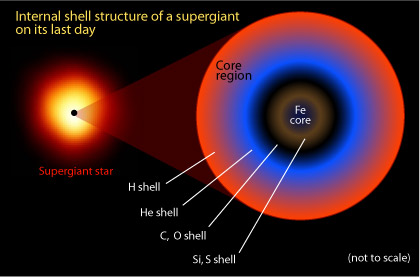

Unlike our Sun, the largest stars undergo a different process. While a smaller star begins to die when it runs out of hydrogen, a massive star continues fusing heavier elements. Stars can be thought of as "factories" that produce other elements from hydrogen and helium. In fact, the carbon that makes up all living things was forged within these larger stars.
When the core runs out of helium, the star contracts until there is enough heat and pressure to begin the fusion of carbon. The star develops several layers around its core like an onion, with the core fusing the next heaviest element and the layers each continue fusing the previous elements.

This process continues until the core is full of iron (Fe). Unable to continue the fusion process, the iron core collapses under its own mass. This collapse of the core produces a shockwave called a Supernova, which blows off the outer layers of the shell, along with many of the elements produced in those layers which may contribute to the production of new stars. A Supernova is often bright enough to outshine all other stars in it's galaxy.

A Supernova leaves behind a Neutron Star: an incredibly dense star that can contain twice the mass of the sun in a tiny radius of about 10 kilometers. However, in the case of exceptionally massive stars, a Black Hole may be left behind instead of a Neutron Star.